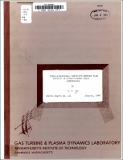| dc.contributor.author | Tan, Choon Sooi | en_US |
| dc.contributor.other | Massachusetts Institute of Technology. Gas Turbine and Plasma Dynamics Laboratory | en_US |
| dc.date.accessioned | 2016-09-27T19:59:08Z | |
| dc.date.available | 2016-09-27T19:59:08Z | |
| dc.date.issued | 1980 | en_US |
| dc.identifier.uri | http://hdl.handle.net/1721.1/104425 | |
| dc.description | January, 1980 | en_US |
| dc.description | This is part 1. Part 2 issued as his Asymmetric inlet flows through axial compressors, GT & PDL report no. 151 | en_US |
| dc.description | Originally presented as the author's thesis, (Ph. D.)--in the M.I.T. Dept. of Aeronautics and Astronautics, 1978 | en_US |
| dc.description | Includes bibliographical references (pages 184-188) | en_US |
| dc.description.abstract | A new analytical method is proposed for the study of flow through highly-loaded turbomachine stages. The technique is used in the present study in order to: (i) analyze the three-dimensional induced effects of the viscous blade wakes in an isolated rotor; and (ii) to study the effects of the passage of distorted flow through an axial compressor rotor or stator. In Part I (GT&PDL Report Number 141), it is found, in contrast with the more familiar situation behind aircraft wings, that the induced effects of the vorticity in the (viscous) wakes are important in practical axial turbomachinery; for example, the flow angles through highly-loaded rotors are modified to a significant extent by such wake effects. The induced disturbances grow in strength within a certain distance downstream of the blade row before beginning to decay inversely with such axial distance. | en_US |
| dc.description.abstract | In agreement with earlier predictions, pressure disturbances and vorticity disturbances cannot be decoupled in swirling flow. Similarly, in part II (GT&PDL Report Number 151), it is found that major differences arise on comparing two-dimensional with three-dimensional analyses, both for rectilinear and for annular configurations. Further, only the last of these three-dimensional analyses can adequately describe the true flow phenomena in highly-loaded turbomachines. This is because such a description properly includes both centrifugal effects together with two important distinct types of vorticity: the trailing vorticity and the vorticity associated with any stagnation pressure gradients present. Such an analysis predicts, a strongly persisting downstream pressure field which in many cases increases before again beginning to decay inversely with the axial distance downstream, both for free-vortex stators and rotors. | en_US |
| dc.description.abstract | By contrast, three-dimensional wheel flow analysis predicts indefinitely persisting downstream disturbances. Further, a purely two-dimensional theory indicates for a stator, the downstream static pressure to be uniform, while even a three-dimensional rectilinear cascade theory would predict only an exponentially decaying pressure field. The amplitude of the above persistent downstream disturbances decreases for free-vortex downstream flow as the number of significant circumferential harmonics of the inlet distortion increases. These analytical results agree well with available experimental data recently obtained in annular cascades. | en_US |
| dc.description.sponsorship | AFOSR Contract F49620-78-C-0084 | en_US |
| dc.format.extent | 188 pages | en_US |
| dc.publisher | Cambridge : Massachusetts Institute of Technology, Gas Turbine & Plasma Dynamics Laboratory, [1980] | en_US |
| dc.relation.ispartofseries | GT & PDL report ; no. 131 | en_US |
| dc.relation.ispartofseries | GT & PDL report ; no. 151 | en_US |
| dc.subject.lcc | TJ778.M41 G24 no.131 | en_US |
| dc.subject.lcsh | Turbomachines -- Blades | en_US |
| dc.subject.lcsh | Compressors | en_US |
| dc.subject.lcsh | Viscous flow | en_US |
| dc.subject.lcsh | Vortex-motion | en_US |
| dc.subject.lcsh | Aircraft gas-turbines | en_US |
| dc.title | Three-dimensional vorticity-induced flow effects in highly-loaded axial compressors | en_US |
| dc.type | Technical Report | en_US |
| dc.identifier.oclc | 06612094 | en_US |
